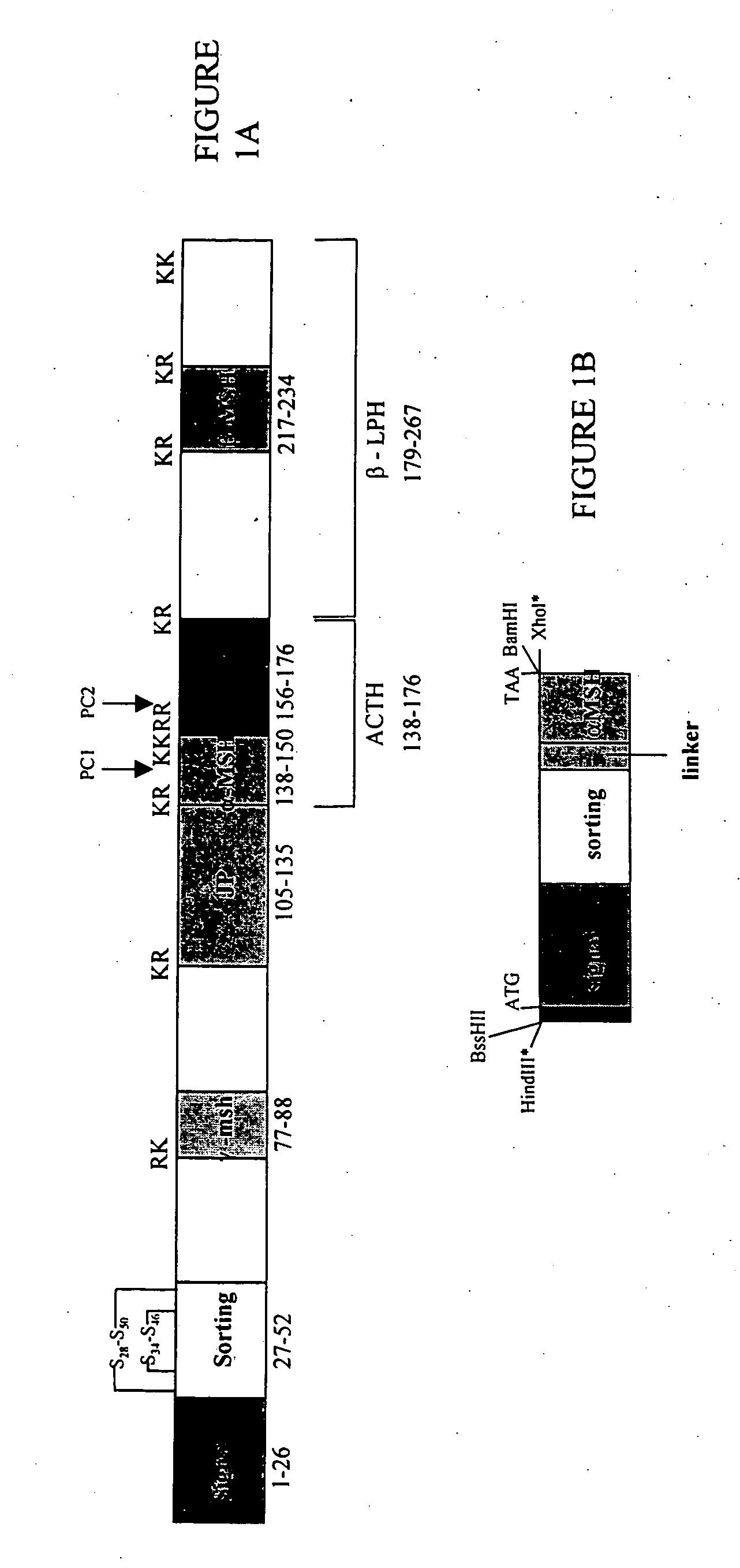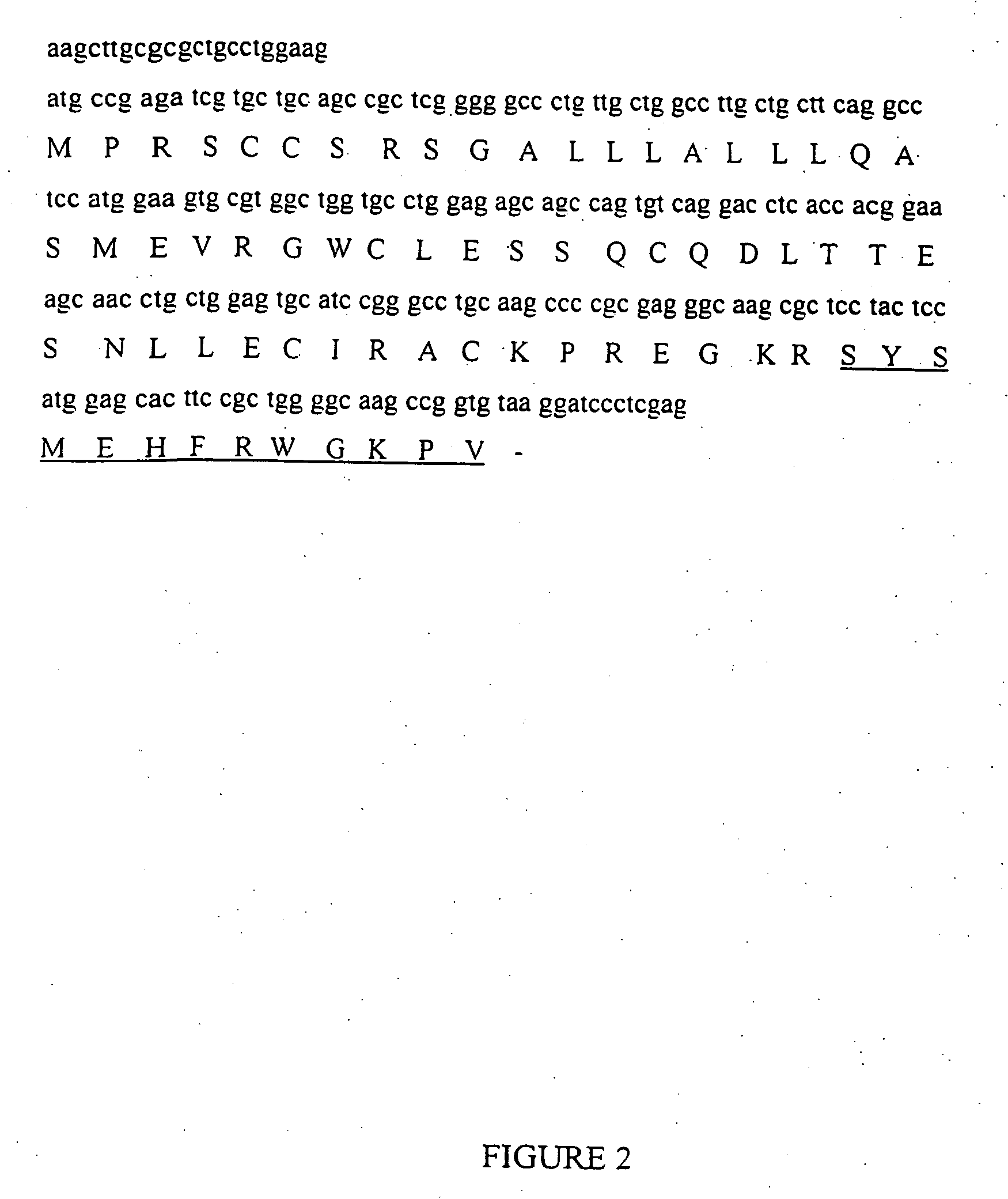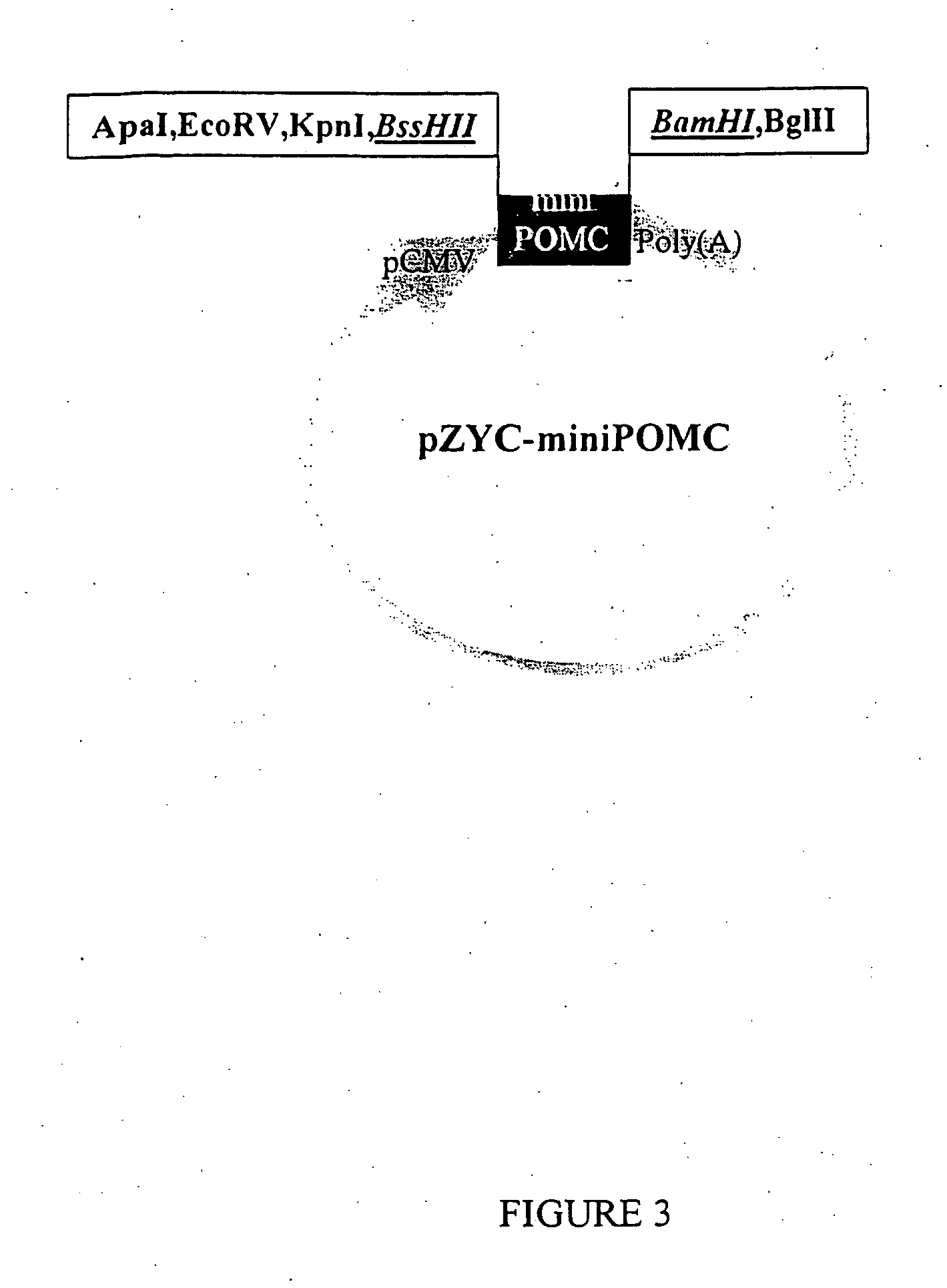Methods of treating bladder disorders
a technology of bladder disorders and urethral resection, which is applied in the direction of antibody medical ingredients, peptides, genetic material ingredients, etc., can solve the problems of insufficient control of the superficial transitional cell carcinoma (tcc insufficient urethral resection (tur) of the bladder, and increased urinary frequency, so as to reduce antibody production, reduce immune complex deposition, and reduce the effect of histamine releas
- Summary
- Abstract
- Description
- Claims
- Application Information
AI Technical Summary
Benefits of technology
Problems solved by technology
Method used
Image
Examples
example 1
Construction of MiniPOMC Expression Vectors
[0072] The structure of the POMC polypeptide is depicted in FIG. 1A. The location of various regions and features of POMC are indicated by reference to specific amino acid residues indicated below the depiction of the polypeptide. A polypeptide consisting of POMC amino acid sequences 1-26, 27-52, 138-150, and a linker sequence is depicted in FIG. 1B. This polypeptide has been designated miniPOMC. The construction of nucleic acids encoding miniPOMC is described in this example.
[0073] Oligonucleotides encoding the human POMC signal peptide, the human POMC sorting peptide, a partial junction peptide, and the α-MSH sequence SYSMEHFRWGKPV (SEQ ID NO:4) were synthesized in vitro. The POMC oligonucleotides were constructed based upon the human POMC cDNA sequence (GenBank™Accession NM—000939).
[0074] The synthesized oligonucleotides were annealed and subcloned into HindIII and Xhol sites of pCMV-Script (Stratagene, San Diego) to generate the plas...
example 2
Construction of α-MSH / Serum Albumin Fusion Polypeptides
[0077] Three α-MSH / serum albumin fusion polypeptides are depicted in FIG. 4. The constructs contain: (a) mouse serum signal peptide (MKWVTFLLLLFVSGSAFS; SEQ ID NO:20) or human serum albumin signal peptide (MKWVTFISLLFLFSSAYS; SEQ ID NO:21); (b) mouse or human serum albumin propeptide (RGVFRR; SEQ ID NO:22); (c) the first 195 amino acids of the mouse serum albumin
(EAHKSEIAHRYNDLGEQHFKGLVLIAFSQYLQKCSY(SEQ ID NO:4)DEHAKLVQEVTDFAKTCVADESAANCDKSLHTLFGDKLCAIPNLRENYGELADCCTKQEPERNECFLQHKDDNPSLPPFERPEAEAMCTSFKENPTTFMGHYLHEVARRHPYFYAPELLYYAEQYNEILTQCCAEADKESCLTPKLDGVKEKALVSSRV; SEQ ID NO:23)orhuman serum albumin(DAHKSEVAHRFKDLGEENFKALVLIAFAQYLQQCPFEDHVKLVNEVTEFAKTCVADESAENCDKSLHTLFGDKLCTVATLRETYGEMADCCAKQEPERNECFLQHKDDNPNLPRLVRPEVDVMCTAFHDNEETFLKKYLYEIARRHPYFYAPELLFFAKRYKAAFTECCQAADKAACLLPKLDELRDEGKASSAK; SEQ ID NO:24);(d) a linker(GGYGG; SEQ ID NO:25);(e) a furin site(RIRR; SEQ ID NO:26);and(f) an α-MSH sequenceSYSMEHFRWGKPV.
[0078] T...
example 3
Instillation into the Bladder and Measurement of the Inflammatory Response in Mice
[0080] Cystitis is induced in mice as follows. Groups of 16 mice are sensitized intraperitoneally with 1 μg of dinitrophenyl (DNP4) human serum albumin in 1 mg of alum on days 0, 7, 14 and 21. The protocol induces sustained levels of immunoglobulin E (IgE) up to 56 days post-sensitization. One week after the last sensitization, cystitis is induced by antigen challenge intravesicularly with 150 μl DNP4-ovalbumin (1 μg / ml). Control mice are given 150 ul of saline. To ensure consistent contact of substances with the bladder, infusion is repeated twice within a 30 minute interval. Cystitis is measured between 1 and 10 days post-sensitization by examination of histological sections for infiltration of inflammatory cells and degranulated mast cells (Saban et al. (2000) Am. J. Pathology 156:775-80). Mast cell number and activation can be measured using morphological analysis (Saban, et al. supra). Histologic...
PUM
| Property | Measurement | Unit |
|---|---|---|
| body weight | aaaaa | aaaaa |
| time | aaaaa | aaaaa |
| size | aaaaa | aaaaa |
Abstract
Description
Claims
Application Information
 Login to View More
Login to View More - R&D
- Intellectual Property
- Life Sciences
- Materials
- Tech Scout
- Unparalleled Data Quality
- Higher Quality Content
- 60% Fewer Hallucinations
Browse by: Latest US Patents, China's latest patents, Technical Efficacy Thesaurus, Application Domain, Technology Topic, Popular Technical Reports.
© 2025 PatSnap. All rights reserved.Legal|Privacy policy|Modern Slavery Act Transparency Statement|Sitemap|About US| Contact US: help@patsnap.com



